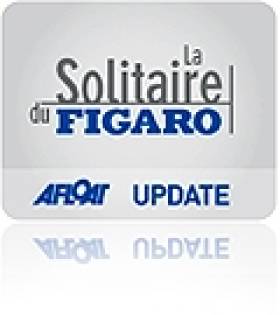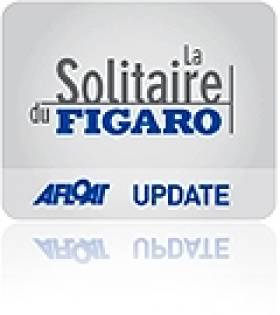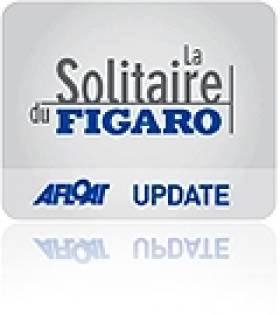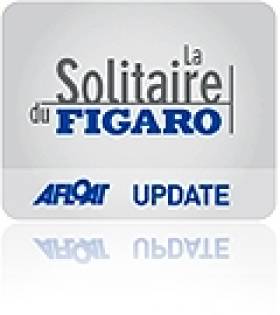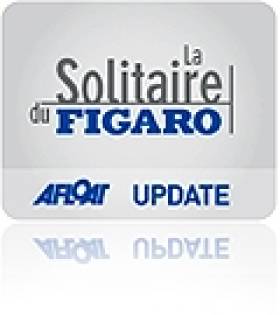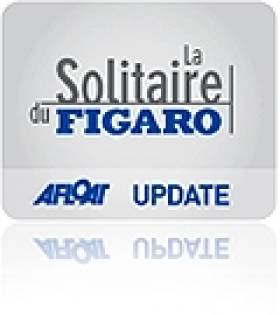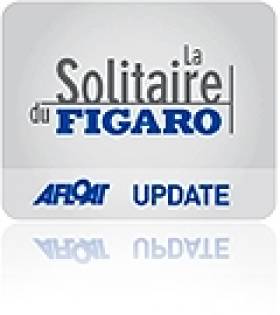Displaying items by tag: David Kenefick
La solitaire du Figaro - the big race - started today at 13:00 and for young David Kenefick it was indeed a big occasion. 10,000s of people had come to see the 41 solo sailors head off on the first leg which takes the fleet down the Gironde estuary from Pauillac and out across the Bay of Biscay to Cape Finisterre and down Spanish and Portuguese coast to Porto, 535 miles. After weeks of horrible weather summer switched on this morning, the temperatures soared into the mid-20s and the sun burnt everyone who ventured outside.
The Gironde Estuary is a bit like the Solent only three times as long. The race start was set for just before high tide to allow the fleet to start and do some local round the cans racing in slack water for the crowds, sponsors and live TV show, before heading down the river with the start of the ebb. But as everyone knows the tide never turns evenly in a river or narrow arm of the sea. It always turns on the edges first and it was to the edges that the fleet split for the first mile and a half beat upwind against the tide.
David had a terrible start and was amongst the backmarkers off the line, which put him in a poor position for the first beat as he tried to hang in. He was amongst good company though with some big scalps near him. The problem is there are big scalps all over the fleet. This is a race of attrition and just finishing every leg is a major sailing and seamanship achievement. The goal for David now is to settle himself down and stay in a low risk mode for the rest of the Gironde Estuary and once out in the Atlantic with the kite up start to get rested and get into a routine that will see him lucid enough to make the right decisions at the right time further down the track.
The first casualty of this rather unusual early part of the course is a fellow rookie competitor and perhaps favourite rookie Frenchman Simon Troel. He was having a great race and was in 12th place but has gone aground on a mud bank and will have to wait out the tide before he can get off. That will cost him the race as this race is ranked by cumulative elapsed time, not points and a 12 hour deficit this early in the race will be hard to recover from.
The fleet will see spinnakers set as the pass the Pointe de Grave and head out into the Bay of Biscay. They are expected to have downwind sailing all the way to Cape Finisterre in a building breeze before a complex low slows the game down as they head south towards the Portuguese finish port of Porto. They are expected to finish sometime late on Wednesday night or early on Thursday morning this week.
We'll keep regular updates going on www.afloat.ie page over the next three weeks.
David Kenefick Relaxed & Ready for the Sail of his Life
#fullirsh – David Kenefick's bid for Figaro success as a rookie is underway in Paluillac, France this afternoon after month's of preparation brought the solo Irish sailor to the start line at noon today.
This morning shore teams gave the final touches to the boats and checking each and every detail on board. Earlier the skippers attended the usual pre-start weather briefing led by Météo Consult expert Cyrille Duchesne and gathered for the traditional group photo shooting.
Photos from yesterday's prologue race in the heart of Bordeaux show a relaxed David Kenefick at the helm of Full Irish, organised and focused above all the Cork sailor is now relieved just to be getting on with the job.
The original plan yesterday was to have all 41 boats race about 3 miles up the narrow river but due to a flood up the river several miles away, a dam was needed to be opened which caused a load of trees and some were over 30 feet long to flow down the river. It was to risky to send all the skippers out to race as they could hit a large log and do some damage.
So at 2pm the organisers made a decision to allow the skippers to take as many crew as they wanted to safely sail the race. It was not a race thought but a spectacle for the 25/30k people who lined the 2.3mile shore line on both sides of the river. They staggered the starts in boats of 4, until all 41 boats sailed up the river to the finish.
David's Dad Neil is in France and (pictured below) sailed the race yesterday with David yesterday.

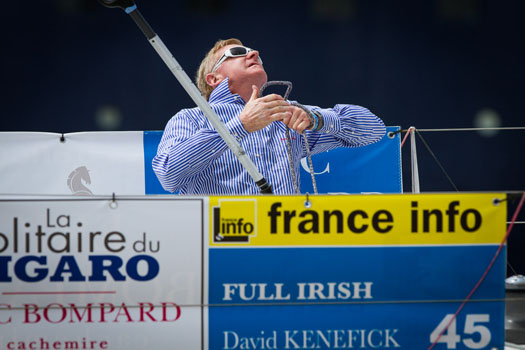
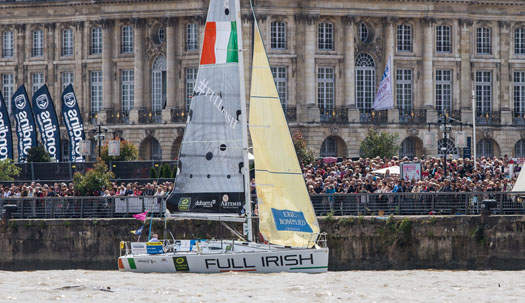
#fullirish – Three days before the start of the Solitaire du Figaro now. I have still got a bit to do, but I can see the light at the end of the tunnel. I have been very fortunate to sign two sponsors to my project this week, the Port of Cork and a French company le Comptoir Irlandais.
The Port of Cork is amazing for me as I took my first step afloat in Ireland's greatest stretch of water and its wonderful to have them onboard as I spread my wings abroad. Le Comptoir Irlandais is a fantastic partner and it has come about because of my boat's racing title FULL IRISH. That was a bit of a play on my identity in France, as you can see the boat sports a big tricolor in the mainsail and on the hull. The Comptoir Irlandais is a chain of 46 shops across France that sells everything in the food and clothing department that we do well in Ireland. They have a huge selection of Whiskeys, Irish foods and Irish woolen products. I believe they are the biggest client for Jameson in France. I guess I'm helping the export cause and I can't tell you how amazing this feels to be able to help our country as I compete in this race. Thanks to everyone for their help.
So on to the racing programme. We have a short Prologue race on Saturday to take us from Downtown Bordeaux to a small town called Pauillac half way down the Estuary, a bit like moving the show from Cork City Centre to Crosshaven only much further. This allows us to start Leg One on Sunday a mammoth 536 miles to Porto. So we race down the final 30 miles of the Gironde estuary before heading across the Bay of Biscay to Cape Finisterre and down the West coast of Spain and Portugal to Porto. Weather is looking to be OK for a relatively straight forward passage at the moment although our daily weather and strategy briefings with our brilliant coach Nico Berenger.
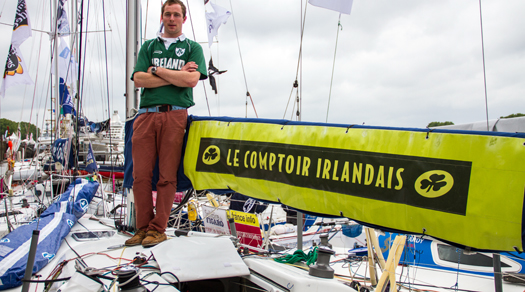
Rolling out the new sponsors colours today in Bordeaux. Nice Shamrock! Photo: Brian Carlin
I ordered a new small jib recently which is due to show up today. When that arrives and I've put the food on the boat I'm about ready to go. I'll try and update again tomorrow but it is getting busy. I have to say though, I am fairly relaxed, the most I've ever been before an event. I hope this continues. More soon and thanks for your support.
#fullirish – With five days to go to the start of Leg One of the 2013 Solitaire du Figaro Ireland's David Kenefick reports in from Bordeaux, the start port.
There is so much to do during this week before the start of the Figaro. I hadn't realised how intense it would be in spite of being told over and over again by those around me. I guess that is experience. Interestingly many of the French skippers aren't even in town for the first few days of the week, leaving all the formalities to their shore crew. The Rookies are all here, getting it together, and I'm one of them and its great.
So safety checks, measurement checks, sealing of heavy weights in the boat, radio checks, AIS checks, nav equipment checks, and that's just the organisers and scrutineers. Its all for a reason, our equipment has to work and there would be remorse and liability if anything happened and in hindsight things were not done to best practice Protocols.
'I won't be drinking much wine but it will be interesting to see how these vineyards work'
I have sponsor obligations too. This could be seen to be inconvenient but that would be to miss the point. Our sponsors are amongst the reasons why we have been able to get to this stage and this is their time as much as ours to get the return, sell the products and be talked about. One of our sponsors is Patton Watches and I proudly wear one on my wrist. They have a stand in the village and everyday one of the six non-French skippers spends some time with the staff there signing posters and postcards of us racing our boats. They have made a significant contribution to our logistics pool for which we are all extremely grateful. And it gets better. Which ever of the six of us does the best in the event on points wins their top of the range sailing watch, a rather smart analogue chronograph produced in association with Harken.
Last week my team secured some more sponsorship for me and we will announce this later this week. It is very exciting to now be able to partially justify my existence commercially and this is the best possible training ground for me to learn how it works in the big bad world of professional/commercial sailing ventures.

David (right) Signs photographs of Ireland's 'Full Irish' campaign in Bordeaux. Photo: Brian Carlin
We are in Bordeaux and tomorrow night all 41 skippers have been invited to dinner at one of the famous wine Chateaux. It is Chateau Pichon and the guy who runs it, Yannick Evenou, and invited us is himself an ex-Figaro sailor from the 1990s.
I won't be drinking much wine but it will be interesting to see how these vineyards work.
More soon
Kenefick Ready for Today's Solo Concarneau Race
Cork's solo sailor David Kenefick, along with the rest of the Figaro fleet, is tackling his last race before the Solitaire du Figaro next month. The event is called the Solo Concarneau. It starts at 14:00 Irish time today. The 340 miles long race sees the fleet race up and down the French coast almost as far as Ushant to the North and Ile d'Yeu to the South.
The disappointing thing about this race is that there is no tracker system so we are going to be a lot less informed about what is going on than our last reports from the Solo Arrimer race in April.
Nevertheless it will be interesting on many counts. below please find team maanger Marcus Hutchinson's latest blog.
This is another race but with many differences. The sailors are better prepared than for the Solo Arrimer - they are by definition now twice as experienced as before - the weather is completely different and most importantly the chips are down. At stake is an entry in this year's Solitaire du Figaro. Winning the Solo Concarneau wouldn't necessarily guarantee a place but finishing 'down the pan' will certainly see an early exit.
An honest race is what is required from both the Artemis candidates. Honest in the sailors' ability to anticipate and react to the many obstacles and constant little challenges that are the solo sailor's lot.
They say that preparation is everything but until you see why some things are important and others less so it is difficult to know what to prioritise. There is no point being the fastest if you go the wrong way or get lost in the fog. There is no point sailing the perfect course if you don't have the energy to push the boat as hard as you can. There is no point having a smooth bottom and a fair keel if your electronics go down. In short there is no point being here if you aren't able to deal with adversity and rebound quickly.
The guys are far from perfect but they are better than before. The weather will be kinder to them this time too. It seems they have spent far too much time fighting 40-knot winds and not enough dealing with the subtleties of lighter winds and most significantly the transitional phases more commonly found in these conditions.
The competition is here again. This time there are 30 starters with all the usual suspects. The course also sees them sail through the challenging Raz de Sein, for the first time alone and, although we are in neaps, there will be quite a lot of tidal sailing to be dealt with.
The course sees the 30 boat fleet head upwind around the Glenan Islands before turning across the wind to PenMarch and then downwind North across the Bay of Audierne through the Raz de Sein and up and around Pierre Noire just South of Ushant. This hairpin bend will then see the fleet reaching South and then South East outside everything to the Brivideaux lighthouse, which is near the Quiberon Peninsula, before hardening up a little bit to head South down to and circumnavigating Ile d'Yeu. The return North to Concarneau and the finish is the longest single leg. It will start as a close reach and the fleet will be slowly headed as they come North and will finish the race upwind, maybe even short tacking along the coast for the last 50 miles!
The first part of the course will require some tactical nous and then some strategically strong decisions. The next part of the course from the Pierre Noires down to Yeu will require one overwhelming element. SPEED. The return leg will require force of character to stay fast, fight the fatigue and the ability to chose the right moments to sail high or sail low as the wind ultimately heads the fleet and turns a reach into a long beat.
There should be winds peaking in the mid-20s on Wednesday morning but other than that we should see a fairly medium-breezed race. What remains to be seen is if there will be any important transitional phases that fall between light and dark and light.
Regrettably this race doesn't have a tracker system running and so we will be reliant on AIS and Marine Traffic.com to see progress around the track along with the infrequent updates from the radar enabled Semaphore/Coastguard Stations that are still scattered the length of the French coast line. Finish time for the first boats is expected to be late afternoon on Wednesday, the stragglers can be expected a few hours later.
We have a busy few days immediately after the finish of the Solo Concarneau as some of the boats in this Anglo-Irish squad will be trying new sails and specifically sails with their Figaro Race livery, all especially for the camera of our resident photographer Brian Carlin. The two Artemis boys Ed Hill and Jackson Bouttell will be informed as to whether one or both of them will sail the big race, and then there is the preparation to move the whole show to Bordeaux by sea and road 10 days later.
Exciting times indeed. Keep this frequency clear!!!
Rookie Solo Sailors - How Tough is Tough?
There is a reason the Figaro Class has a Rookie prize in every event they run. And it is highly sought after writes Marcus Hutchinson.
The French call it the Bizuth prize. In the Solo Arrimer there were six 'Bizuths', three French two British and one Irish.
Starting out in this singlehanded game is tough, not only because it IS really, really tough!!!! but because you don't really know what you are getting into in detail until you actually go and do it, a few times, in a range of different conditions. You only learn and get better from practice.
Figaro sailing is not just about learning how to manouvere the boat by yourself and find fast sail settings and manage the transitions and be tactically astute.
A long offshore race is tough for anyone. But until you go and try and do all of those things by yourself, for a long, long time you wont understand the importance of the different parts of preparation. Hence, real reward for the Rookies.
Along with his Artemis Offshore Academy Rooky buddies Ed Hill and Jack Bouttell, David Kenefick has been slowly ramping up his exposure to longer and longer races, to races with more and more entries and a higher standard and to racing in complex parts of the world with tide, rocks, Atlantic depressions, cold and wet.
This event, the Solo Arrimer, is the next step in that path and there will be another similar race in three weeks time in Concarneau. Three weeks after that the Rookies, along with everyone else who enters the Solitaire du Figaro will be doing four slightly longer races back to back with just a couple of days recovery time between each leg. This is a truly epic sporting undertaking for a young man or woman to undertake and it needs to be taken seriously.
No one is under illusions about what is involved in supporting the Artemis team and David. Those three young men are beginning to now understand more and more about how much they didn't know.
When they started they didn't know what they didn't know, now they are beginning to learn what it is they don't know and soon they will know everything that they don't know.
Only then can they go about removing the long list of don't knows and become experienced. You are a Rookie for one season only. It is rare indeed for a Rookie to finish in the top five. Over that last 44 years of the race a Rookie has placed in the top five on only a handful of occasions.
David Kenefick Racing for Figaro Qualification
#SoloArrimer – David Kenefick is racing in 21st position this morning after his first night at sea in the Solo Arrimer race in the Bay of Biscay. It is a 320 mile coastal race that has huge significance for the Royal Cork novice sailor as it is one of only two qualification chances for his goal of participation in the La Solitaire du Figaro race in two months time.
The 22-year-old Crosshaven sailor moved up two places into 20th position as he rounded the Pertuis Antioche Buoy at midnight.
The fleet headed North for 90 miles through the night to Gouvé Vast Buoy near the Quiberon Peninsula. In building winds the fleet was on a two sail reach, a tough leg.
The testing Solo Arrimer race off Les Sables d'Olonne is against 25 of the world's top solo sailors. Former Irish Figaro solo sailor Paul O'Riain of Dublin commented: 'What a line up of solo sailors, it's the who's who of solo sailing; Le Cleac'h (the Jeckyl), Desjoyeaux (the professor), Elies, Duthil, Lunven, Beyou...Vendee winners, multiple Figaro winners, jesus you picked a good fight David for your first big outing, Love it.. brilliant.'
Kenefick is expected back into the French port of Les Sables d’Olonne in the small hours tomorrow (Sat).
Track David's progress here.
Track RCYC's David Kenefick in Solo Arrimer Race Here!
Follow David Kenefick's progress in his final qualification race for this Summer's figaro race. Today's race at 320nm miles is the longest the Crosshaven sailor will have completed to date. He's also lining up against some of the best French skippers. more here.
No Host Port for Ireland in 2013 Figaro
#Figaro - The course for this year's Solitaire du Figaro has been finalised - with no Irish port in the lineup.
The Daily Sail details the four legs of the 44th edition of the prestigious and challenging single-handed offshore race, that will take the fleet from Bordeaux to Porto, Gijón, Roscoff and Dieppe - with no changes from the course unveiled in December.
But despite indications that Ireland would have a host port on the race route, following previous stop-overs on Kinsale, Dingle, Howth, Crosshaven and Dun Laoghaire, it appears this summer's running will be a purely continental event.
Even so, Ireland will be represented among the competing fleet by the brother of last year's Sailor of the Year David Kenefick, who is set to make his Figaro debut.
The Cork Harbour helmsman, who came second in the La Grande Motte recently, discussed race tactics as he steps up his training ahead of the race from 2-23 June.
First Route Announcement for 2013 Solitare du Figaro
#FIGARO - Part of the route for next year's Solitaire du Figaro has been announced at the Paris Boat Show, as The Daily Sail reports.
Organisers Pen Duick have unveiled a four-leg course from 2-23 June that takes in three host ports in France - two of which are welcoming the famous single-handed race for the first time.
The 44th edition of the Solitaire du Figaro begins on 2 June in Bordeaux from where the fleet will head to Spain and Portugal before returning to France, racing along the Channel via Roscoff and the treacherous Bay of Morlaix towards Dieppe in Normandy, which previously hosted the race in 2009 and 2011.
Next year's race is also set to visit Ireland - following previous stop-overs in Kinsale, Dingle, Howth, Crosshaven and Dun Laoghaire - though organisers have yet to nominate the lucky town that will have the honour of hosting the fleet.
Among those competing in the prestigious race will be Ireland's own David Kenefick.
As previously reported on Afloat.ie, the 21-year-old Cork Harbour helmsman will likely be the only Irish entry in what is one of the world's toughest offshore challenges.





























